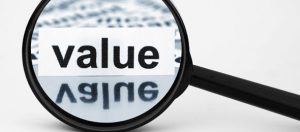Valuing Your Business
To Create Value In Your Business You Must Know This
Do you know what your business is worth to an investor or a bank? Do you care? More importantly, do you really know what drives the value of your business to grow? And should you care? If you said revenue growth you are wrong. Just because one company has revenue of $1m and second has revenue of $3m does not mean the second is worth more than the first. If you answered my question with “income growth” then you were correct, but only partially.
You see if that $1m business has and adjusted net income of $500k but the $3m business has adjusted net income of only $400k, the $1m business is probably worth more. But if they are projecting slower earnings growth than the $3m company, then the $3m company may be worth more. So, what really drives value?
The definition for the valuation of any asset that generates income is value = the asset’s ability to generate adjusted net income (EBIDTA) into the future, forever, adjusted for the time value of money and risk. That may be a mouthful for you, but let’s break it down starting with an asset’s (your business’s) ability to generate adjusted net income into the future…forever.
EBIDTA is nothing more than your projected Net Income (Earnings) with 4 adjustments made. The EB stand for Earnings Before. To be sure we are on the same page, Earnings equal Net Income which is equal to Total Revenues (Income) minus all costs including Costs of Good Sold (COGS) and Overhead (S&GA) expenses. Cost of Goods Sold are those that are directly associated with producing the goods and/or services being sold. Overhead are all other expenses. If you are paying income taxes you will also deduct those taxes to obtain your Net Income, or Earnings.
Before means you add back the following 4 expenses: Interest is added back because if you have interest expense in your overhead it is a result of your decision to incur debt. Other owners may have sufficient cash to avoid that expense, so it is deducted from your expenses (or added back to your net income); Depreciation is an accounting expense that is not a real cash outlay. The money was spent when the asset that resulted in the depreciation was purchased. Not being a real cash outlay, we remove it from expense. Taxes are likewise removed because if the business was set up as an S corp LLC there would be no taxes, so the expense is a result of the way the business was incorporated, not a true business expense. Finally, Amortization, like Depreciation is a non-cash outlay expense that is removed.
And yes, our expectation is that you are setting up a business that will be an asset generating net income for the long term (forever). But that does not mean we expect you to provide us a pro forma projecting EBIDTA for 1000 years, 3-5 years…maybe in extreme cases 10 years, will suffice and that has to do with the first adjustment to EBIDTA noted above…the time value of money.
The time value of money is simply this: If you give me a dollar today I can invest it at some interest rate, let’s say 10%, and in 1 year I have $1.10. If you are projecting to give me $1,10 in one year it is only worth $1 to me today. Likewise, if I keep that $1,10 another year at 10% I will have $1.21. If you are projecting to give me $1.21 in two years it is only worth $1 today. We value assets in terms of today’s dollars, meaning the first adjustment we make to your projected EBITDA is to discount each projected value back to today. Even your first year’s earnings are discounted because, as an investor, I will not benefit until the results are in one year from now. So, if you project to have EBITDA of $1,100,000 at the end of year 1 I will value that today at $1,000,000.
To make a full adjustment for valuing your projected EBIDTA we will take the “present value” of the EBIDTA projected for each year and then take the average to calculate the value. As a result, assuming a 10% discount rate (current rates are 6-8%) anything projected after the 10th year is actually worth $0 today, hence why we only really care about 3-5 years of projections.
The other adjustment is risk. Several things go into the estimation of risk, but to calculate the value of your business they are manifested into an interest rate we call the capitalization rate. The more risk that we perceive you have in your business, the higher the interest rate and, hence the lower the valuation. The ultimate calculation is: value = EBIDTA divided by the capitalization rate. For example if the present value of your average projected EBIDTA is $100,000 and the perceived risk is 10% your business is worth $1,000,000 ($100,000/.10=$1,000,000). But if the perceived risk is 50% your business is worth only $200,000…do the math.
So, while you may have a great set of financial projections and/or awesome financial history, the value of your company is based on much more. Ultimately it is based upon perceived risk and what capitalization rate is used. All of my blogs discuss the various risks that pertain to this perception. Understanding them, documenting them, and internalizing them are the key to increasing the value of your business. Your challenge this week is to start building the pillars of a valuable company…now.
Mitchell Bolnick – The Excel Consulting Group

